NDEs and Shifting Psychic Gravity
the sustained psychological peace that follows a near-death experience

It’s hard to imagine an event more compelling than a near-death experience (NDE). I’m sure you’ve heard tales about those rare few who have ventured to this liminal state, those lucky enough to experience a bright light at the end of a dark tunnel, all while emerging safely to the other side. NDE survivors often report a …
Keep reading with a 7-day free trial
Subscribe to Deep Fix to keep reading this post and get 7 days of free access to the full post archives.



